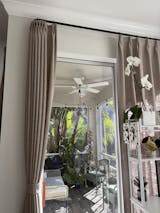How to Create a Sustainable, Eco-Friendly Home without Sacrificing Design
By Ashley Patterson
Looking to make your home more sustainable but worried about sacrificing style? You’re definitely not alone. The good news is that eco-friendly design has evolved far beyond beige hemp curtains and reclaimed wood everything (though both can be lovely in the right setting!).
After years of implementing sustainable practices in my own projects and spaces, I've developed practical strategies that balance environmental consciousness with gorgeous design. Here are five of my most effective approaches to eco-friendly home renovations and decor updates that won't compromise your aesthetic or break your budget.

Design: Instillerie
1. Embrace the Art of Slow Decorating
One of the most sustainable approaches I've adopted is simply slowing down. In our culture of instant gratification, it's tempting to furnish an entire room at once from big-box retailers. Instead, I've learned to embrace the hunt for vintage and second-hand pieces that bring character and reduce waste.
This vintage secretary in our Brooklyn apartment took months to find, but it's now one of our most treasured pieces. Not only does it have a story, but the craftsmanship is leagues beyond most new furniture at similar price points.

Design: Instillerie & DeLuzuriaga Studios, photo: Sean Litchfield
2. Repurpose and Refinish Vintage Treasures
Often the construction on vintage pieces is much more solid and made to last than anything you'll buy at a big box retailer today. And you can get it much cheaper! My current sofa was sourced for $300, and then reupholstered in gorgeous floral and velvet fabrics for a truly one-of-a-kind piece. Yes, reupholstering costs money, but I ended up with a custom piece that's built to last for around what a new mediocre sofa would have cost.

Design: HiLo Brooklyn, photo: Chaunté Vaughn
3. Rethink "Renovation" Altogether
When considering a renovation, ask yourself if it needs to be a full gut renovation or if there are alternatives. Sure, a whole glossy new kitchen would be nice, but is it necessary?
At our Connecticut lake house project, we opted for a more budget-friendly and eco-conscious approach by painting the existing kitchen cabinets (which were solid and high-quality even if the fronts weren't exactly what I would have picked), updating the hardware, and installing new lighting and floating white oak shelves in place of a bulky counter cabinet. These changes not only breathed new life into the space but also made it feel so much more open and airy.

Design: Instillerie, photo: Katelyn Perry
In the downstairs bathroom, we kept the updates simple and sustainable by replacing the old stained floor tile, toilet, vanity, and fixtures while retaining the existing shower insert which was perfectly functional. Even though a full new tiled shower would have been nice, it really wasn't critical, and the bathroom still looks gorgeous.

Design: Instillerie, photo: Katelyn Perry
4. Commission Local Makers
You'll be shocked to find out that the cost of commissioning a piece from a local maker is often less than what you'd pay a retailer, and the economic footprint is drastically better.
For my kids' Brooklyn nursery, we had a very specific corner where we wanted to add a bookshelf with personality without spending a fortune, so we hired a local carpenter to create a custom robot bookshelf (for far less than what it would have cost in stores, in my humble opinion).

Design: Instillerie & DeLuzuriaga Studios, photo: Sean Litchfield
For my son's bedroom in our Connecticut barn home, we had some awkward unused space under the eaves and were (yet again) desperate for a bookshelf, so I made something custom for the space for around $500. It had a way smaller environmental footprint than buying and shipping from a retailer, was way more fun to create, and was way cheaper for something that fit the space perfectly.
5. Choose Natural, Renewable Materials
When purchasing new items, I look for pieces made from sustainable materials:
-
FSC-certified wood or reclaimed timber
-
Natural fibers like organic cotton, wool, and linen
-
Rapidly renewable resources like bamboo, cork, and jute
Do a quick online search before ordering materials or furniture to suss out the most sustainable option from your selection of vendors.

Design: Instillerie, photo: Katelyn Perry
Remember, Small Changes Add Up!
You don't need to renovate your entire home to make a difference. Start small with:
-
Window treatments that help keep spaces cool in the summer and warm in the winter
-
Energy-efficient lighting
-
Low VOC paints
-
Efficient appliance updates
-
Second-hand or vintage decor accents
-
Indoor plants that improve air quality
-
Repairing and refreshing what you already own
When you do need to renovate or purchase new pieces, consider the source, materials, and longevity. Look into companies with transparent supply chains and sustainable manufacturing practices. Research materials with lower environmental impact. And perhaps most importantly, invest in quality that will last for years rather than trends that will soon feel dated.
The most sustainable home isn't one that never changes – it's one where each change is made with intention, where pieces are loved and cared for, and where both environmental impact and personal joy are considered in every decision.




























Leave a comment